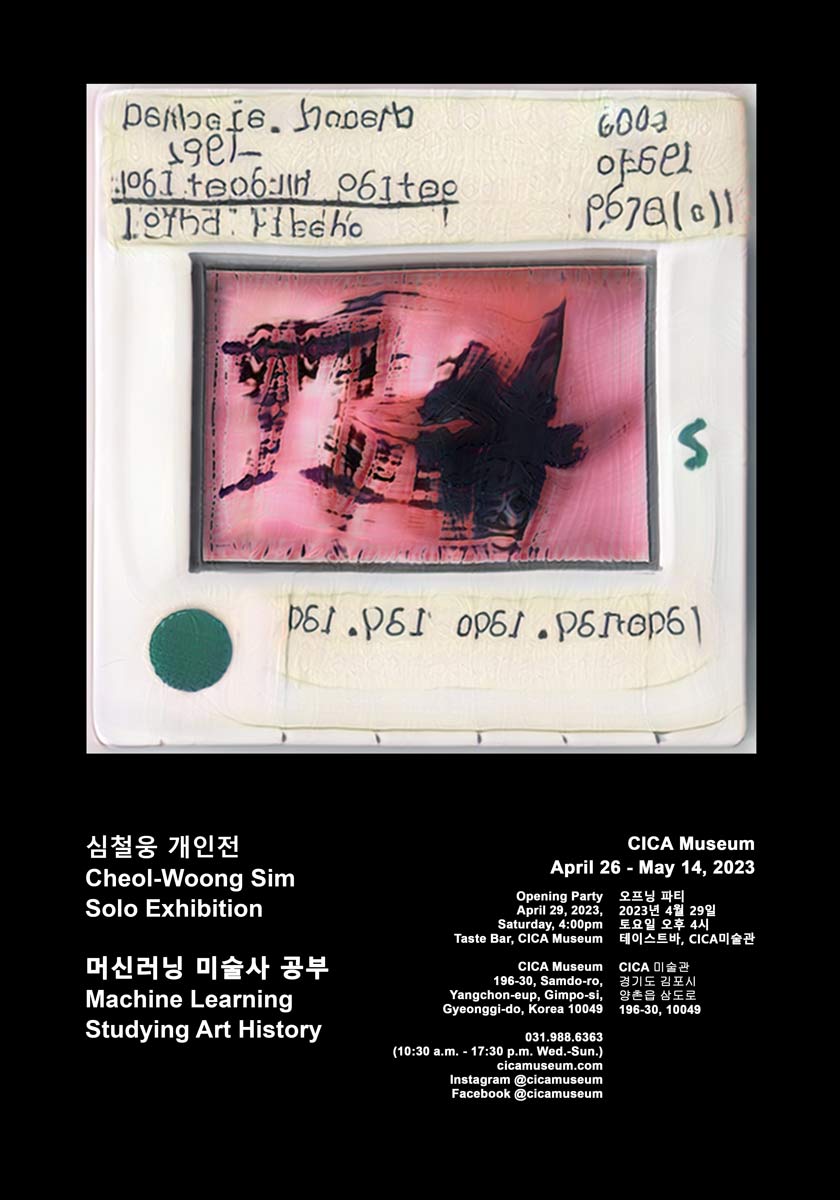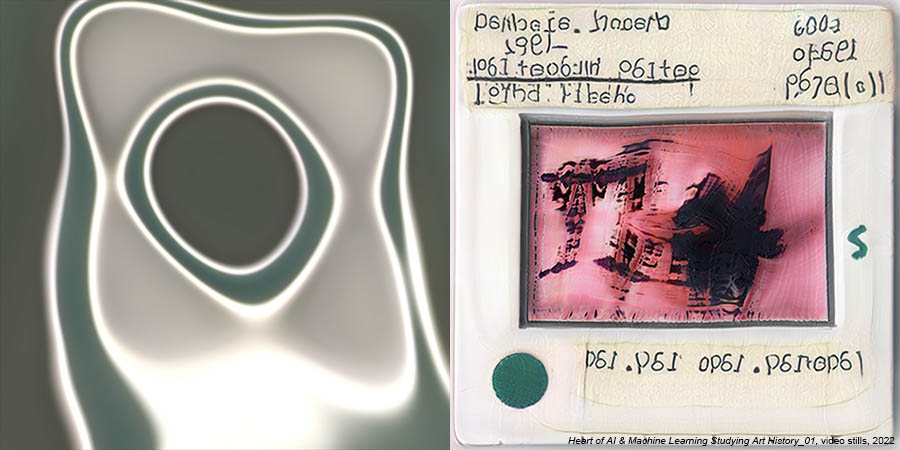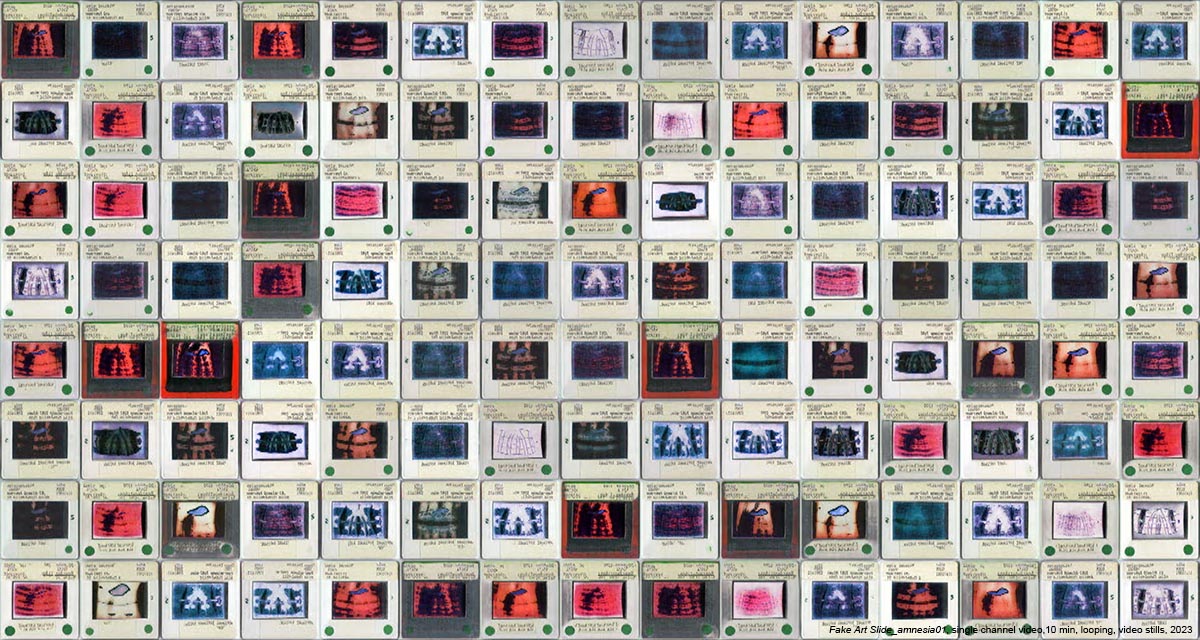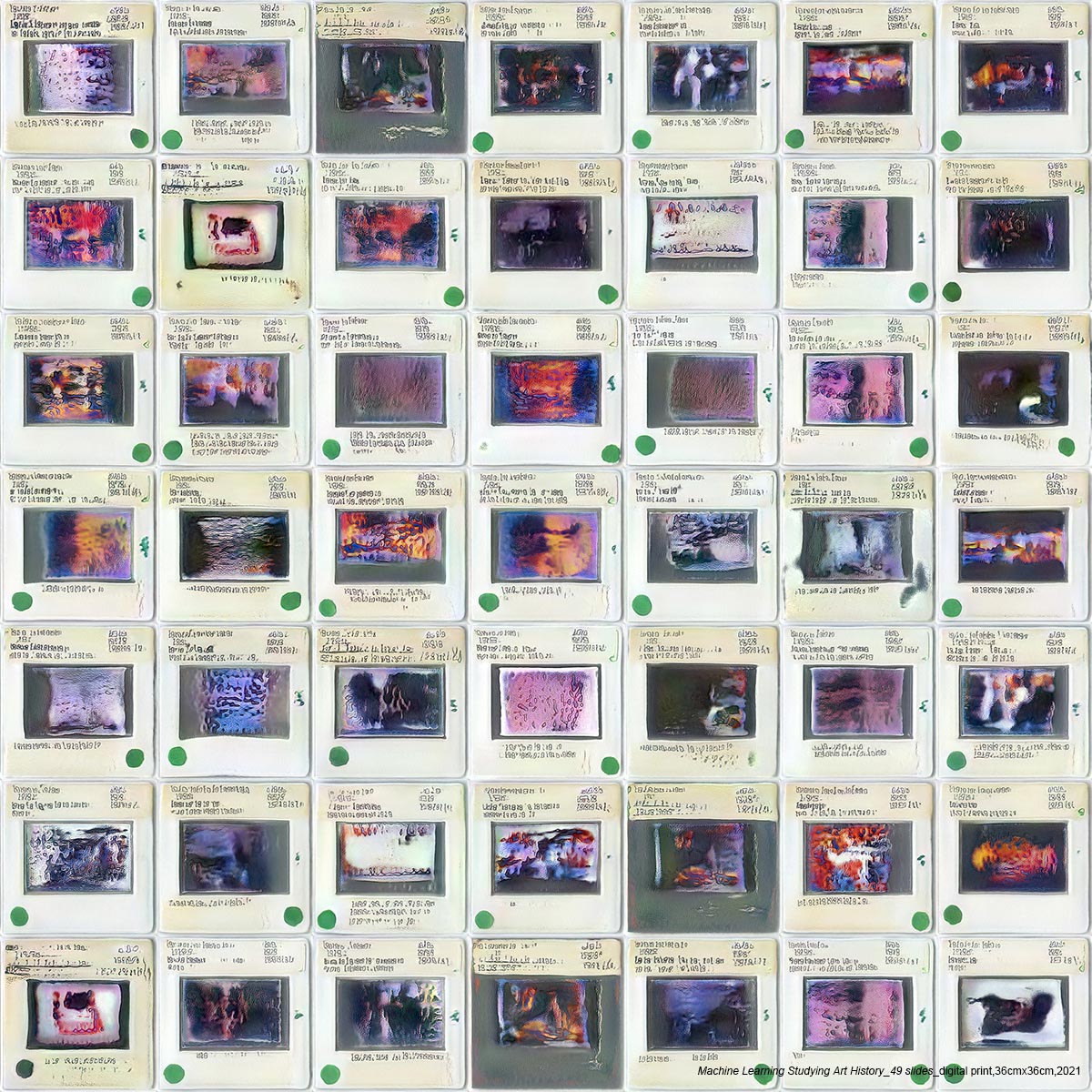Cheol-Woong Sim Solo Exhibition
심철웅 개인전
Media Gallery, CICA Museum
April 26 – May 14, 2023
2023.04.26 – 05.14
머신러닝 미술사 공부
Machine Learning Studying Art History

초대의 글
CICA미술관에서 2023년 4월 26일부터 5월 14일까지 심철웅 작가의 기획 초대 개인전이 열린다. 심철웅 작가는 미술사 수업에서 활용된 작품들의 슬라이드 이미지들을 AI와 머신러닝 통하여 왜곡하고 재창조해나가는 과정을 담은 영상 작품 및 프린트 작품을 발표한다. 심 작가는 한국 현대 영상 미술과 뉴미디어 아트 분야의 영향력있는 작가로서 서울대학교 서양화과 교수로 재직하며 한국 뉴미디어 아트의 흐름을 이끈 장본인이다.
심철웅 작가의 <머신러닝 미술사 공부> 시리즈는 서양 미술사를 중심으로 한 현대 미술의 거대한 담론을 사람이 아닌 AI가 습득해가면서 만들어내는 진실되어 보이지만 왜곡되고, 현실적으로 보이나 기이하기도 한 알고리즘이 만들어내는 독특한 질감을 담는다. 미술을 전공하게 되면 거치는 일방적 미술사 습득과정에 대한 의문과 비판적 시각은 감정이 없는 알고리즘의 시점에서 프로세싱을 거치며 우연적 요소를 만들어내고, 이를 통해 문화와 사회 속 권력 투쟁 (power struggle)에서 오는 무거움과 우울함을 오히려 가벼움과 무심함으로 거울처럼 비추어 보여준다.
<Faces of AI>와 <Heart of AI>는 무채색의 추상적 이미지가 반복되는 영상시리즈이다. 영상은 추상적이기도 하지만 그 속에서도 끝없이 사람의 얼굴을 찾아내려는 인간의 본성과도 닮아있다. 작품은 생기 없는 무채색의 무생물적인 느낌을 주는 동시에 아이러니하게도 반복된 움직임과 함께 기이한 생명감을 지닌다. 이러한 기이함은 불쾌한 골짜기 (uncanny valley)에서 기인한 인간이 아닌 것에 대한 인간다움에서 오는 것이 아닐까? 머신러닝을 이용한 작품들을 감상하노라면 생명이 아닌 코딩 프로세싱에서 오는 무섭도록 차갑지만 동시에 기이하게 매력적인 결을 발견하게 된다. AI를 비롯한 새로운 테크놀로지는 명령어로부터 시작해 끝없이 움직이며 진화하고 결국 기존의 생물과는 다른 새로운 개념으로 살아있게 된다.
심철웅 작가는 새로운 매체와 이미지가 범람하는 급변하는 현대 사회 현상들 속에서 중요한 담론의 지점들을 깊은 인문학과 이론적 이해를 바탕으로 이지적이고 비판적 관점으로 집어내고 있다. 또한 이를 과격한 방식으로 드러내고 행동하기 보다는 개념화와 추상화 과정을 통해 미학적인 이미지들을 만들어내어 관객을 생각에 잠기게 한다. 그는 이번 작품을 통한 활발한 교류를 통해 한국 현대 미술사에 중요한 방향을 제시하고 있다.
김리진, PhD
CICA미술관 아트디렉터
2023.3.25
The solo show of Cheol-Woong Sim will be held at the CICA Museum from April 26th to May 14th, 2023. The show will feature Sim’s video works and print works that utilize artificial intelligence and machine learning technologies to process slide images of works from the Western Art History textbooks. Sim is an influential Korean new media artist and a professor of Painting at the Seoul National University, Korea.
Sim’s “Machine Learning Studying Art History” series was generated from the machine learning process on the Western Art History. The works reveal textures that new technologies created, which seem true but distorted, and realistic yet eerie. His works reflect power struggles in art academia in a rather light and remote way, in spite of the heaviness of the subject matter.
“Faces of AI” and “Heart of AI” serieses are monotone abstract loop video works. Through constant implication of faces and movements of breathing, the works create an odd yet humanlike liveliness of “uncanny valley.” When seeing works generated by AI and machine learning, I personally feel the startling coldness of machines yet find beauty in it at the same time. Starting from commands, AI and new technologies are endlessly being active and evolving, and remain alive in a new way.
The artist Sim pinpoints crucial matters of theoretical and historical discourses in Contemporary and New Media Art. Furthermore, rather than showing them explicitly, he chooses to conceptualize and abstract the matters to give viewers room to ponder. Sim pioneers new directions of Korean Contemporary Art through his works and careers.
Leejin Kim, PhD
Art Director of CICA Museum
March 25, 2023
작업배경
오래전 대학시절, 미술사에서 중요한 해외 유명 작품들을 접할 기회는 대부분 미술사 수업시간이었다. 선생님들이 해외에서 구입했거나 미술사책에 실린 도판을 촬영하여 만든 슬라이드(slide)들이 미술 작품이란 어떤 것인가를 알려주는 거의 유일한 매체였다. 그떄는 해외 여행이 자유롭지 못한 시기였고, 간간히 열린 해외유명 작품전시는 그리 많지 않았던 시절이기도 했다.
졸업 후, 서구 미술을 보다 전문적으로 공부해 보고자 미술사학과로 유학을 갔다. 하지만 거기서도 대부분 미술사 수업은 작품 슬라이드를 통해서 이루어졌다. 물론 미술관이나 갤러리에서 실제 작품을 볼수 있는 기회는 보다 많아졌지만, 여전히 주요 작품들은 슬라이드를 통해서 이해해야만 했다. 그리고 미술사학과의 슬라이드 도서관에서 슬라이드를 정리하고 제작하는 일을 하게 되었는데, 그 당시 수많은 슬라이드를 통해 본 작품 이미지들은 나의 시각적 뇌리에 수많은 점들처럼 축적되었다.
디지털 시대가 되면서 슬라이드는 디지털 이미지 도판으로 대체되기 시작했다. 결국 슬라이드 도서관은 문을 닫았고 수십만개의 슬라이드를 처분해야 했다. 그리고 우연한 기회를 통해서 많은 슬라이드를 불하받았다. 이제 ‘오브제’의 물질로 변한 ‘슬라이드 이미지의 정체성’에 흥미가 생겼기 때문이다.
인공지능 시대가 되면서, 미술작품 ‘슬라이드 이미지 오브제의 정체성’에 대한 의미를 다시 생각하게 되었다. 각 슬라이드는 미술사에서 중요한 작품으로 수업에 사용되었기 때문에, 수업에서 본 슬라이드들이 우리의 시각적 조형적 무/의식을 구성하는데 시발점이자 중요한 근거를 형성할 수 있다는 가정을 하게되었다. 즉, 우리가 갖는 미술에 대한 의식, 조형성에 대한 의식, 작품들의 의미를 구성하는 형태 등에 대한 의식들이 슬라이드를 통한 미술사 교육에서 세뇌된 조형적 인식에서 출발하고, 더 나아가 미술전반에 대한 가치를 결정하는 우리의 인식을 형성하는데 무/의식적인 근간이 되지 않았을까 하는 문제의식이 생기게 된 것이다.
몇년 전부터, 이러한 문제의식을 갖고, 미술의 시각적 조형 인식의 정체성에 대한 작업들을 시작했다. 우리 인간과 달리, 미술사작품 슬라이들을 데이터로 학습한 인공지능은 어떤 조형적 인식을 갖게 될 것인가? 혹시 인공지능이 가진 인식이 우리가 가지고 있을 수 있는 무/의식 속의 조형성의 근간과 어떤 연관성이 있을수 있을 것일까?
이러한 의문을 시각화해보려는 의도로, 미술사 작품 슬라이드를 이미지 데이터로 만들어 머신러닝(Machine Learning) 알고리즘을 통해 이미지를 생성하는 실험적 작업을 시작했다. 작품 슬라이드들을 데이터 이미지로 만들어 머신러닝이 학습하게 하고, 이미지와 영상을 생성하게 한 것을 작업으로 다시 구성한 것이다. 그리고 생성된 이미지들은 마치 미술사 슬라이드에 대한 기억이 상실된(Amnesia) 상태를 보여주는 것이라고 상정하였다. 이러한 이미지들은 끊임없이 움틀거리며 반복되며 왜곡된다. 마치 기억상실의인식 상태를 보여주는 것처럼.
이러한 맥락에서 역사적인 이미지를 데이터로 만들어 같은 방식으로 작업을 시작하였다. 미군정 시기 (1945.9-1948.8)에 우후죽순 (雨後竹筍)처럼 생겨난 이념적 정당 단체들의 깃발(Banner) 일부 이미지들을 머신러닝 알고리즘을 통해 새로운 이미지 영상들을 생성해 내었다. 이것은 당시 정치적 사회적인 시대 상황의 진실부재를 기억상실 같은 이미지의 표상으로 표현하고자 시도한 것이다.
이와같은 작업들은 아직 실험적인 초기 단계이다. 보다 많은 연구 수집과정, 주제와 담론에 의해 구축될 이미지 데이터가 필요하고, 이에 대한 머신러닝 알고리즘의 최적화도 다각도로 작업해야 한다. 본 작업은 끝이 없을 것이다. 슬라이드 이미지 데이터가 보다 많아지면서 머신러닝의 숨은공간(Latent Space)의 고차원 점(Points in high-dimension)들이 매번 새로운 인공지능이 인식한 작품 슬라이드 이미지를 생성할 것이기 때문이다.
심철웅. 2023. 3. 20
Intention of the work
During my college days, the most significant opportunity I had to experience important overseas artworks was through my art history classes. The professors used to show us slides made from photographs of prints found in art history books or that they had personally purchased during their travels abroad. As exhibitions showcasing famous artworks from abroad were rare occurrences at that time, this was my primary means of experiencing them.
After graduation, I pursued further studies in art history abroad to gain a comprehensive understanding of Western art. However, despite the new academic setting, most of the art history classes still relied heavily on artwork slides. Though I had more opportunities to see actual works of art in museums and galleries, the major works still had to be understood through slides during the art history classes. During this time, I worked in the slide library of the art history department, where my responsibilities included organizing and producing slides. As a result, I accumulated a vast collection of images of different artworks, which became ingrained in my visual memory like countless reference points.
With the advent of the digital age, slides were gradually phased out and replaced by digital image prints. Eventually, the slide library had to close down and dispose of hundreds of thousands of slides. Fortunately, I inherited many of those slides and became interested in the “identity of slide images” that had transformed into the material of “objet d’art.”
The emergence of artificial intelligence prompted me to reconsider the significance of the “identity of slide images in the context of objet d’art” within the realm of contemporary art discourse. Given that each slide was treated as an important artwork in art history classes, I began to wonder if the slides we viewed in class could serve as a starting point and fundamental basis for shaping our visual and formal consciousness, both consciously and unconsciously. In other words, our perception and understanding of art, its forms, and the meanings they construct may have been shaped by a kind of brainwashing that originated from our art history education through slides. This raises important questions about whether our perception of art as a whole and the values we assign to it are unconsciously rooted in this perception.
For the past few years, I have been working on the issue of the identity of visual formal recognition in art, and with this awareness, how will artificial intelligence, which learns from slides of art historical works as data, develop its own formal recognition? Is there any correlation between the recognition that artificial intelligence has and the foundation of the formalism that may exist in our unconscious?”
To explore these questions more deeply, I initiated an experimental project to create image data from art history slides and generate images and videos using Machine Learning algorithms. By transforming the artwork slides into data images, I aimed to enable the Machine to Learn and generate new images and videos based on these art slide data images The resulting images are intended to represent a state of amnesia, where the original memory of the art history slides has been lost or distorted. The generated images are characterized by constant distortions, repetitions, and movements, much like a state of perception in memory loss.
In a similar vein, I began to explore the use of historical data images, applying Machine Learning algorithms to some banner images of ideological political groups that emerged during the US military Government era from September 1945 to August 1948. Through this project, I aimed to express the absence of historical truth and the fragmented nature of memory in the political and social context of that time, creating new sequences of images that resembled the disordered nature of memory loss.
The project is still in its experimental stages, and there is much work to be done. Additional research, data collection, and refinement of Machine Learning algorithms will be necessary to create more comprehensive and nuanced image data. Given the complexity and depth of the subject matter, this work may be ongoing and continually evolving. As slide image data accumulates, the points in the ‘Latent Space’ of Machine Learning will generate new artificial intelligence that can recognize artwork slide images more accurately, potentially leading to endless possibilities and further development in this field.
Cheol-Woong Sim, March 2023
심 철 웅
沈 鐵 雄, Sim, Cheol-Woong
cheolsim@snu.ac.kr
Cheol-Woong Sim (born 1958 in Mokpo, South Korea) studied at Seoul National University (BFA & MFA in Painting) and the University of California, Los Angeles (UCLA, in Art History/MA & MFA Visual Communication). He has held 20 solo exhibitions, including <The Watchtower of Ego>(1996) Gallery Icon, <An|other River>, KunstDoc Gallery(2011), <De-sp[l]ace> Art Space Jungmiso(2014), <The Society of Rationing> Kyobo Art Space (2019), <Void, Them> Sehwa Museum of art(2019). And He has also participated in group exhibitions both domestically and internationally, including <City and Video Images> Seoul City Museum (1996), <Scar> Web art 2000 Gwangju Biennale, <A Tale of Two Cities> Busan Biennale (2006), <Landseasky> OCAT-OCT Contemporary Art Terminal, Shanghai, China(2015), <Korean Media Arts Festival 2019> SWPK Gallery, New York(2019). He lives and works in Seoul and Los Angeles USA, and is currently a professor at the Department of Painting at Seoul National University. He is currently focusing on historical data visualization and art history image data using Machine Learning.



